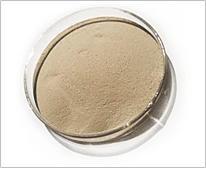Products

Summary: "Songxue" mesothermal amylase is derived from fermentation and refinement of bacillus subtilis, and is commonly applied in starch sugar, alcohol, beer, MSG (industrial hydrolization of starch), feed, textile, dye and many other industries.
I. Physical appearance and technical specifications
Physical appearance |
¡¤Liquid: Brown liquid with high turbidity and slight sediment ¡¤Solid: Light yellow powder |
Enzyme activity unit u/ml£¨g£© |
2000 3000 4000 6000 |
Working temperature |
Optimal temperature 70¡æ-80¡æ |
Working pH value |
Effective pH 5.5-7.0, optimal pH 6.0-6.4 |
Density g/ml |
Liquid: ¡Ü1.25 |
Product standard |
QB1805.1 |
Enzyme activity unit definition: The amount of mesothermal amylase required to liquefy 1mg of soluble starch with 1g solid enzyme powder or 1mg liquid in 1 hour under 60¡æ, pH 6.0.
II. Applications and using methods
1. Beer industry
When using rice and corn as ingredients, first grind enzyme powder through mesh size 40 or finer grate. In liquefying container, add amylase after size mixing. The dosage is about 6u/g. Liquefy 30 minutes at 70¡æ-80¡æ.
2. Textile industry
Use liquid amylase as desizing agent. It is an ideal enzyme for starch removal on fabrics especially for materials such as silk, chemical fabrics and cotton, which can not be processed under high temperature. Suggested dosage is about 0.2%, for 20-40 minutes with a water temperature of 60¡æ-80¡æ.
3. MSG, maltose, glucose, etc.
Mixed with water according to process requirement, adjust the pH to 6.0-6.4, and add 0.2% non-chloride calcium salt. Liven enzyme and thoroughly mix into starch solution. Suggested dosage is 6-8u. If intermittent liquefying technique is used, rapidly increase the temperature to 75¡æ-80¡æ and liquefy for about 30 minutes, or until the diluted iodide test displays a reddish brown color.
4. Other industries
The application of this product in the production of alcohol, citric acid, feed and so on can refer to the characteristics of ketone.
III. Precautions
Dissolve and activate the solid in about 40¡æ water. Small amount of undissolved substance has no effect on the result. If the powder clumps up, crush it before use and this will not affect the result.Above for reference only, the actual dosage is adjustable according to specific situation.
IV. Packing, storage and transportation
Solid: Sealed in 2kg plastic inner bag, with woven outer bag. Net weight 20kg/bag. Liquid: 25kg plastic bucket
Store in cool and dry place and prevent from rain and sunlight. Liquid can retain full activity for a period of 3 months and solid of 6 months if stored at 25¡æ. This product will retain its full activity for a period of up to 1 year at 5¡æ.
V. Features
1. Theory: Able to hydrolyze ¦Á-1.4 glucosidic linkages of starch molecules into smaller random sized units. Rapidly decrease the viscosity of starch slurries. ¦Á-amylase is also called liquefying enzyme.
2. Thermal stability: Stable under 60¡æ. Optimal working temperature 70¡æ-80¡æ. When temperature increases in the range of 70¡æ-90¡æ, the reaction time will decrease, but enzyme loss will increase.
3. pH stability: stable at pH 6.0-7.0. Optimal pH 6.0-6.4. Enzyme loss will dramatically increase if pH is lower than 5.0.
4. Relationship with starch concentration: The thicker the starch slurry or the higher the density of the starch content, the higher the stability of the enzyme.
5. Calcium ion concentration effect on enzyme activity: Calcium ions increase the stability of enzyme activity. The enzyme activity will disappear when there is no calcium ion.
6. Relationship between pH stability and calcium ion: The existence of calcium give enzyme a wide effective pH range, whereas the amylase without calcium ion, the pH effective range is small.



